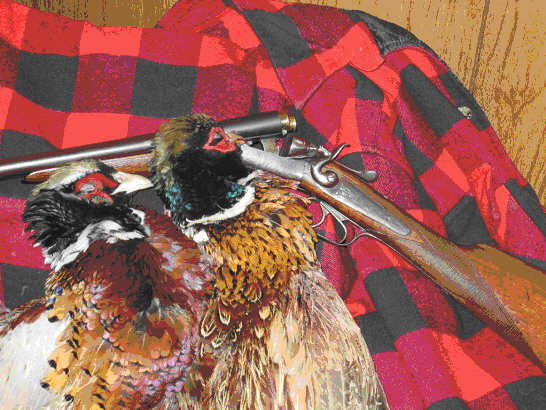It was my first time a
field with my new .410. I could tell Samba, my 2 year old Golden Retriever
was on a bird, she’d become very intense and her tail was wagging faster
and faster as she nosed deeper into the weed patch, closing in on the
hidden pheasant. I moved in with her; suddenly in a cackling burst of
color and motion the rooster took flight. As I raised my gun, I noted
in horror a grayish-white globule being ejected from the birds posterior,
the wind was blowing it right at me. “Yicks! This one’s shooting back!”
I jumped aside and, much to Sambas delight, the globule splattered across
her shoulders. By the time I’d recovered, the bird was about 20 yards
out. Pop! went my .410, sounding more like a toy gun than a shotgun.
To my utter amazement, the bird dropped from the sky.
The .410 has to be the most disparaged gun made, considered by most
to be either a child’s gun, an expert’s gun, or a toy gun. Trust me
when I say this, at 57 I am definitely not a child, those who’ve shot
clays with me know I’m no expert, and based on my experiences with it,
the .410 is definitely not a toy.
Anyone who’s trained a gun dog knows that it takes a lot of birds. The
first year I spent training Samba I shot over forty birds, not cagey
tough-to-shoot wild birds, but rather they’re pen-raised brethren, what
I’ve come to call p-burds. Shooting that many p-burds with a 12 gauge
quickly became a bore, to liven things up I first tried a 20 gauge.
The 20 gauge was a little more challenging, but not by much. Then one
day I was going through a rack of used guns and came across a vintage
Lefever .410 Nitro Special sxs double, just the medicine for p-burds!
I’m sure that by now all you pheasant hunters are just itching to own
one of these little rascals. However, the .410 is not an ordinary gun
and there are several secrets to getting p-burd busting performance
from the little gun.
| |
1. The .410 is not nearly as forgiving as a 12 gauge,
when you get one make sure it fits you and next, shoot it at skeet,
sporting clays or five stand a few times to get used to it, before
you take it a field.
2. Forget about taking long shots, the .410 is a 25 yard gun, if
you make a shot past 25 yards consider it a gift.
3. Unfortunately, most .410’s are choked full, the logic being that
the small shot load must be concentrated. Since we are shooting
within 25 yards, a much better choke selection is modified, improved
cylinder, or skeet. If you’re shooting a double or O/U try skeet
or IC for your right barrel and modified for the left. For a single
barrel gun, such as a pump or automatic, either an IC or modified
choke is a good choice.
4. Normally one uses #5 or #6 shot on pheasant, since the 3” .410
shell only holds 11/16 of an ounce of shot, a better choice is #7.5
shot. By using #7.5 shot you get nearly the same pellet count as
one ounce of #6 shot. Now before you say that #7.5 shot is too small
for pheasants please remember, we’re only shooting birds at a range
of 25 yards or less. Based on my experience, the p-burds can’t tell
the difference. |
If you stay within the
above-prescribed parameters, I guarantee you’ll find the .410 to be
a fun and effective p-burd gun. I’ve hunted pen-raised pheasant for
two years now using a .410 and even though I consistently make 4 out
of 5 shots, I’m still happily surprised when I see the bird drop after
hearing the anemic little pop the gun makes.
By the way, here’s something for you engineers. As many know, the method
of determining a shotguns gauge or bore diameter is pretty archaic,
the current system goes back over two centuries to when the gauge was
measured using a round lead ball. The gauge
number was actually determined by how many equal size lead balls
would make a pound, thus for a 12 gauge you would use a lead ball equal
in weight to 1/12th of a pound, a 20 gauge was measured with a lead
ball that weighed 1/20th of a pound, and so on until you get to the
.410.
The .410 is the only popular shotgun that uses the actual bore diameter,
measured in parts of an inch, rather than the archaic lead ball derived
method. Here’s some more .410 trivia: Though some people call the .410
a 36 gauge this is a misnomer, if you do the math you’ll find that the
.410 is actually a 67 gauge!
For those who would like to learn more about the .410, try looking up
http://www.4-10.co.uk on the internet or read Ron Gabriel’s new book,
British & American .410 Shotguns.

A pair
of pheasants taken last winter with the authors British made .410 sxs
shotgun.
|